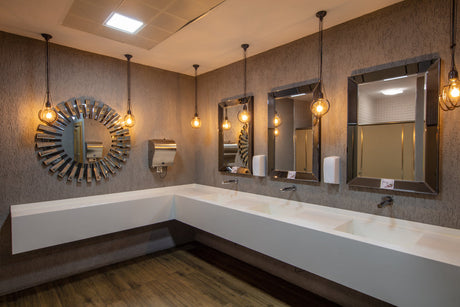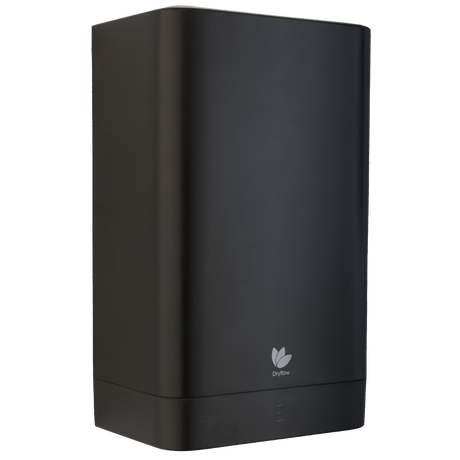
Now that you know how sensor taps work , we will tell you their main features comparing them with manual and press taps.
While some benefits of sensor taps are undeniable, other elements in the list will be more or less negative in relation to one’s needs and expectations. We have classified the features in three categories : advantages, neutral points and disadvantages.
Advantages of Sensor Taps
Automatic taps contribute to a more sustainable world in two main ways:
- Water conservation : Finding ways to save water is very important. Electronic taps are usually designed with a low flow rate, an aerator in the spout and system or materials that prevent leakage. For instance, while traditional basin taps pour between 10 and 15 litres per minute, Giampieri sensor taps would not use more than 6 litres and their solenoid valve is closed by default (and placed before the hose, which in this case supports up to 15 bar). Bear in mind that a dripping tap can waste between 300 ml and 1 litre per hour.
- A small office of just 7 people could save 12378.60 litres of water a year installing automatic taps, the equivalent of 155 full baths
- Energy saving in the long term : Each sensor tap requires 6, 9 or 12 volts, depending on the brand. This expense is unavoidable, whether hardwired or battery operated. Nonetheless, e-taps can make a difference during activation. Selecting the preferred flow and temperature every time a traditional faucet is activated wastes energy, among other things. In this regard, automatic basin taps with a constant temperature (cold, warm or premixed) are a great choice for commercial washrooms. Likewise, thermostatic faucets would be more energy efficient in showers than mixer lever ones.*These settings can be even more environmental friendly if power comes from renewable energies and if further restrictions are implemented in the tap handle or in the rest of the system (aerators, flow limiters, pressure reducing valves). The latter gadgets sound a wise choice also for those who are still using traditional basin taps.
Water and energy efficiency reduce the total bill amount in dwellings. A British household needs on average 360 litres each day and a portion of it can significantly decrease from 30% to 50% by placing sensor taps in the bathroom and kitchen.
In order to know how much water you are wasting and how to avoid it, you could make a water audit of your premises. If you are interested in how much you are spending at home, check this water calculator .
In motion sensor taps water flow is already customised . Adapting the flow once and then again seems time consuming. What is the point of selecting our desired water flow every time we use the washbasin tap if 99% of the time we want the same flow?
The fact that the flow rate is preset also means a cleaner area in the bathroom, since splashes during activation are not possible. In this respect, the self-closing mechanism will not lead to sink overflow and users’ dirty hands would not be touching the tap.
In sanitary facilities with touch free taps, one does not have to get dirty again reusing the same lever or handle and there will not be cross-contamination between users through the tap. Despite that, some suppliers have disposable spouts for sensor taps, designed for healthcare environments that aim at ensuring hygiene.
Main English regulations regarding accessibility in washrooms (mostly Document M ) expect faucets to be “easily operated”. Sensor taps are simple to manage by all kinds of users, including children and those with painful hands (arthritis), dexterity limitations and other mobility restrictions. Furthermore, single supply automatic taps can also pour cold or premixed water, so nobody will be scalded, which is essential for people with any degree of insensitivity.
With improvements in design, technology and elements like aerators, tapware is getting quieter , which is welcome by everyone, but overall by users with certain mental conditions. Our Giampieri sensor taps are lower than 25 dB(A) or 20 dB(A) when there is water pressure under 5 or 3 bars respectively; as silent as a library conversation.
Unlike other types of taps, solenoid valves of sensor taps are protected by plastic, therefore there is no chance of corrosion .
Water pressure will not affect the closing of an electronic valve. For their part, press taps may remain opened if water pressure decreases (it happens when several non-concussive taps are pushed at the same time).
Did you know you can complement an automatic sensor tap with an automatic soap dispenser and / or hand dryer? All in the same location for maximum convenience! An example is the Dryflow Bi-Tap Series. Watch the video to find out more.

Visit our automatic sensor tap range

Neutral features of sensor taps
Newbies will need a few seconds to realise how to use a touchless tap. A clear sign explaining that it is a motion sensor tap helps to cut down confusion. After such an initiation, visitors will know from then on that automatic faucets are a possibility in washrooms, like we all did with manual and push taps.
All faucet filters need to be checked regularly, including those inside the sensor tap system. Cleaning tap filters is fundamental before using the electronic tap for the first time and after a water cut.
Since smart taps require power, they will run out of battery eventually. Most models in the market will let staff know the need for a replacement with LED warnings. There are different battery options, but they will last for at least 1 year.
Disadvantages of sensor taps
Price range is wide and, as always, you usually get what you pay for, but sensor taps probably imply more initial investment than traditional taps, plus a remote control is necessary to change the default settings. Nonetheless, touchless tapware saves costs in the long run, especially for commercial washrooms, and just one remote control can adjust an infinite number of compatible automatic taps.
If there is a water cut, one cannot use the faucets. If there is a power cut , mains operated sensor taps will not work either. Nevertheless, let’s count how many times a year businesses face power cuts or what the chances are that users go into a commercial washroom during a blackout, let alone reaching the basin.
Hands free taps work with an infrared sensor . This widget may have problems with reflective surfaces and extremely bright colours. Installers must read carefully the mounting instructions that the manufacturer provides in order to avoid mirrors or polished chrome finishes opposite the tap sensor, as well as another built-in sensor right in front of it. Despite following the guidelines, beware that sensored taps can make activation mistakes from time to time.
When acquiring automatic taps for houses, it looks reasonable to know that some domestic animals could activate them unintentionally, mainly in the kitchen. Imagine that a cat walks on the basin countertop where a sensor tap is accommodated… It will definitely result in a feline fright, but also in endless water waste. E-taps include a default limit opening time of approximately 1 or 2 minutes to avoid vandalism, mistakes or situations like this one.
While touch free taps avoid cross-contamination, some reports suggest that certain materials (like rubber in the solenoid valve diaphragm) and designs in the internal circuit could favour bacteria proliferation. Therefore, when performing the regular maintenance and cleaning, we encourage to flush often and disinfect the sensor tap components.
Due to the simpler design of smart taps, they work with fewer replaceable parts when comparing with traditional faucets. Should faults occur, replacing the whole unit seems more likely. Now though, sensor taps normally have an extensive guarantee period.
Choosing the Right Sensor Tap
Electronic taps have quite a lot of objective pros: environmental friendly, cost saver in the long term, with constant flow and accessible to all users. However, one must think as well about their so-called cons and the particular variables such as the traffic of the washroom (is the initial investment worth it?) or location (for example, are there plugs in the premises?).
We advise you to analyse the options in the automatic tap market paying attention to specifications like the type of power supply, water pressure, flow rate or maximum temperature. We provide sensor taps for basins, both wall-mounted and deck-mounted, mains or battery operated, made by the world’s top manufacturers, with high quality components and contemporary design. You can find WRAS approved sensor taps in our catalogue too. Do not hesitate to contact our team if you have any questions or special requests (lower water flow, different metal finish…).
For more information about which is the best sensor tap to choose click here
For more information or for help in finding your ideal hand dryer or washroom product, please call us UK offices: North: 0114 3540047 South: 0203 3270448; Eire office: +353 19036387, use our contact us page or click to visit the website .
In the trade? Don’t forget we can set you up with a trade account for your purchases.
We have wholesaler, contractor, public sector and charity discounts available, please don’t hesitate to ask or find out more information.









